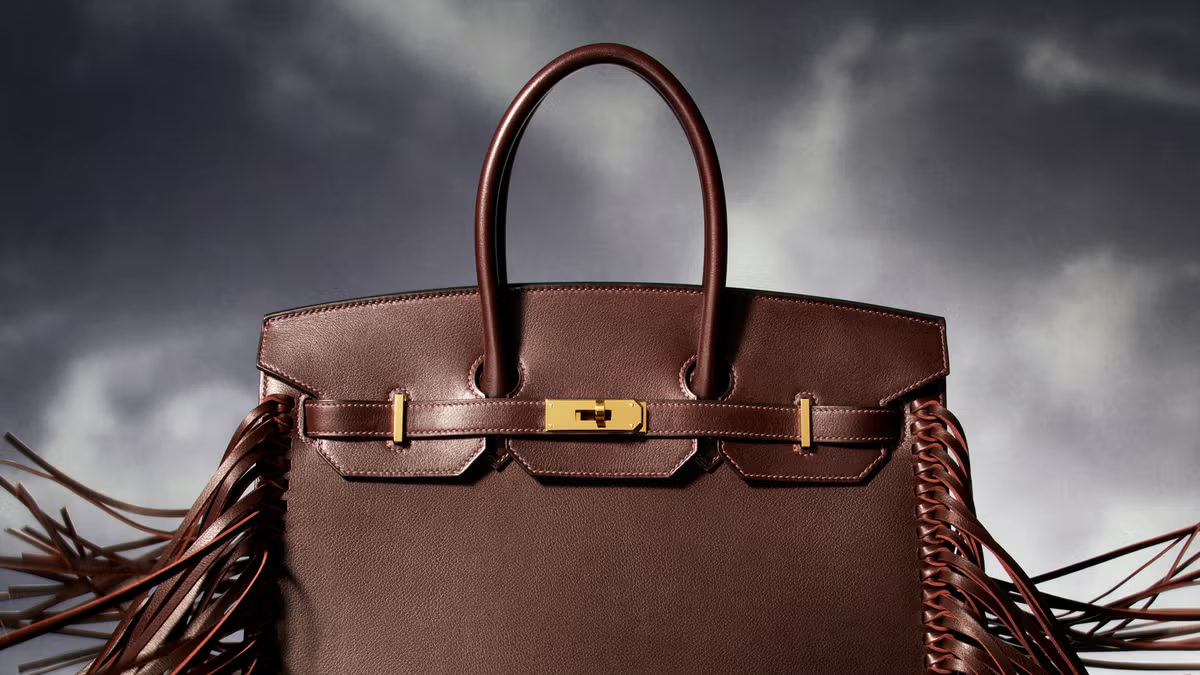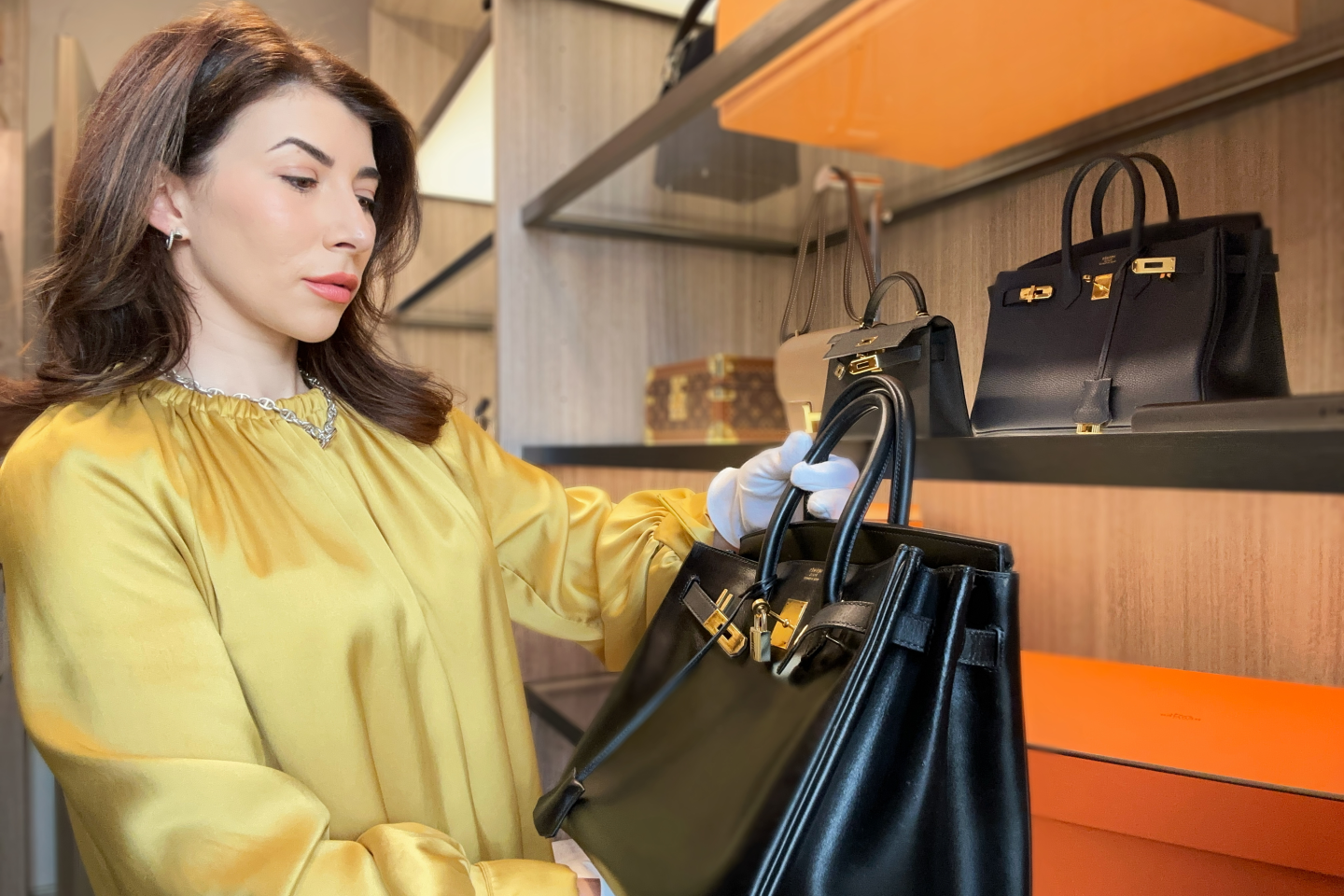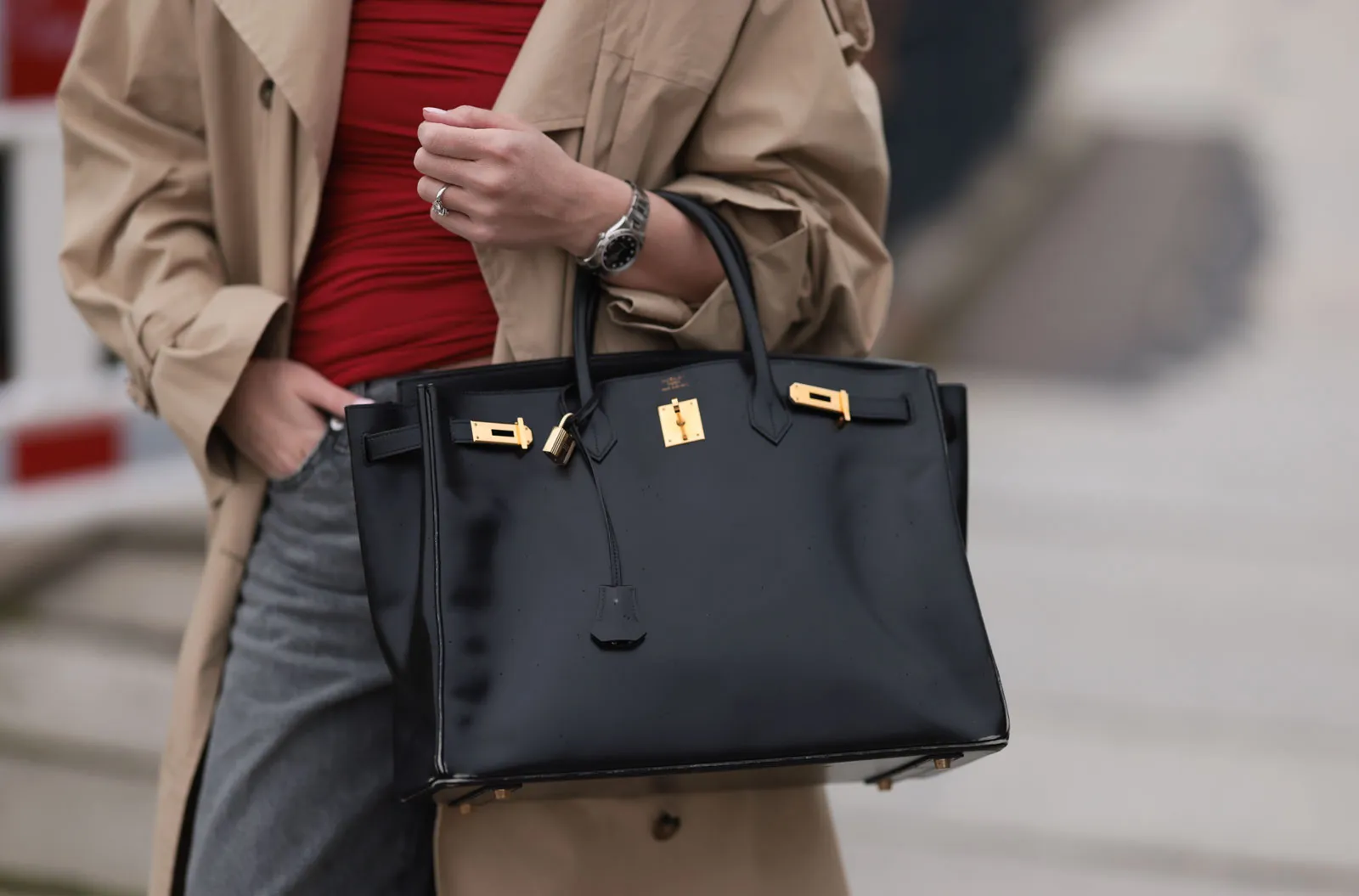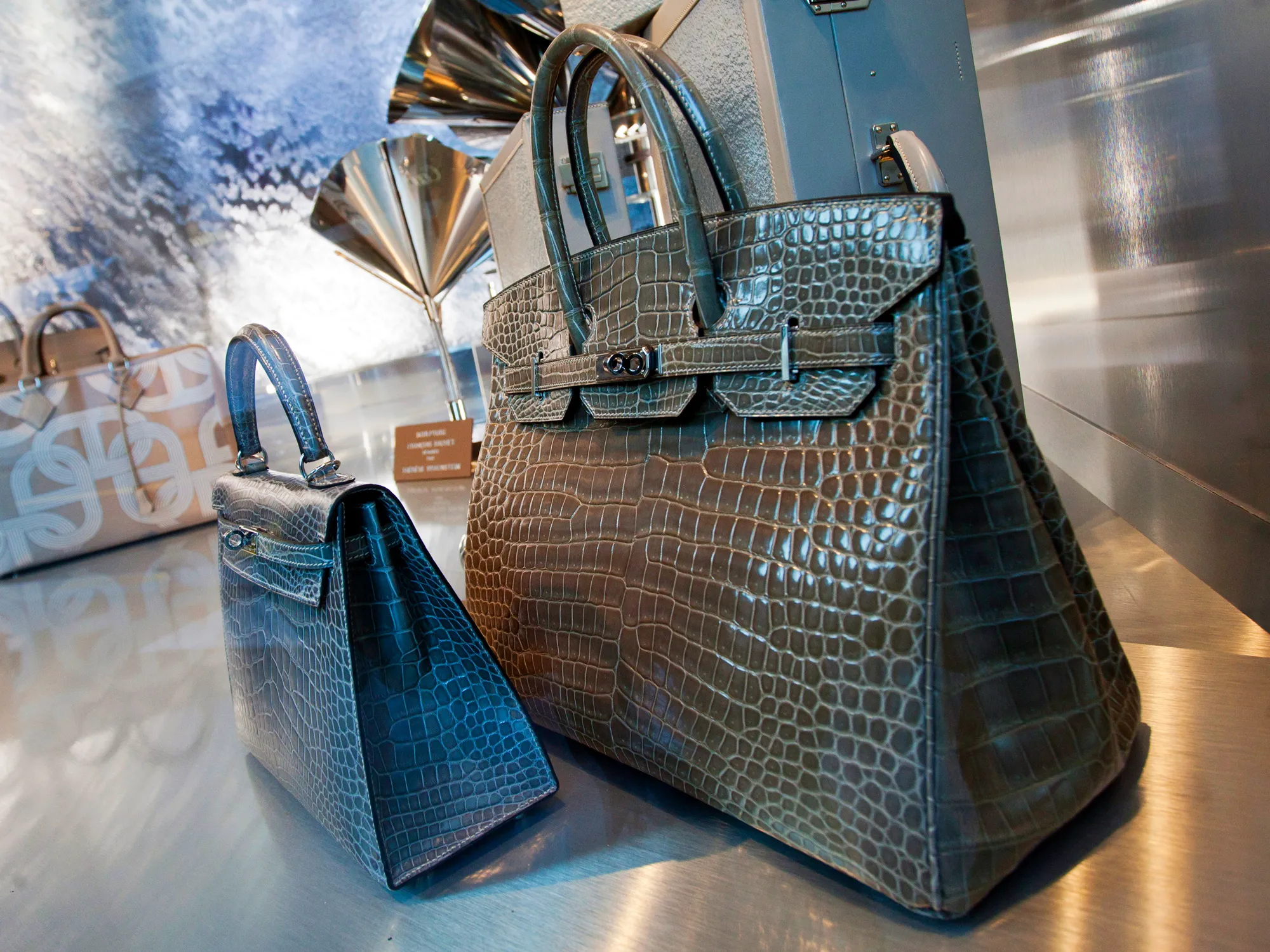ICONOCLASSE
Dépêche des Arts et ModesTHE CULT OF BIRKIN
by Thea Elle | July 16, 2025 | The Luxury Industrial Complex
Long before it became a coveted symbol of wealth and status, before it was immortalized in rap lyrics and locked away in temperature-controlled vaults, the Birkin was just a bag. Not even that at first—just an idea, scribbled hastily on an airsickness bag during a 1984 Air France flight from Paris to London. Jane Birkin, the British-French actress, singer, and accidental style muse, was seated next to Jean-Louis Dumas, the then-CEO of HERMÈS. As legend goes, she lamented the absence of a proper weekend bag—something roomy yet refined, practical enough for diapers and baby bottles, yet elegant enough to carry onto a plane without apology. It wasn’t a calculated design brief; it was an offhand remark made by a woman juggling motherhood and a career, searching for a bag that could hold her life without weighing it down. Dumas, ever attuned to the whispers of his clientele, took out his pen. On the back of that airsickness bag, he sketched what would become one of the most storied accessories in fashion history. From that moment of chance, the Birkin was born—not with fanfare or strategy, but with a kind of organic spontaneity that perfectly mirrored Jane herself.

A classic silhouette in black, carried with confidence and modern flair.
Whispers of Millions: Jane Birkin’s First Bag Set to Stun at Auction
Jane wasn’t asking for an icon. She wasn’t dreaming of a future heirloom, an investment piece, or a symbol of rarefied luxury. She wanted utility wrapped in elegance. A bag that could handle her chaotic, creative, uncurated life: a book or two, her daughter’s toys, her essentials tossed in without ceremony. Yet over the decades, what emerged was something far bigger—something Jane herself could never have predicted. The Birkin became a totem. Not merely a handbag but a cultural artifact, worshipped as shorthand for wealth, power, taste, and entry into an elite, rarefied world.
Fast-forward four decades, and the irony deepens. Jane’s original Birkin—the very first prototype ever created for her—is about to go under the hammer at Sotheby’s in Paris. The auction house, known for orchestrating record-shattering sales of fine art and historical artifacts, has called it “the crown jewel of modern luxury.” Collectors from New York to Hong Kong are already whispering their intentions, their advisors circling like hawks. As for its estimated value? So high it is whispered, not printed. Auction insiders murmur figures that sound more like property prices than handbag valuations.
How a Diaper Bag Became a Luxury Religion
The Birkin’s ascent from a weekend carryall for a working mother to the holiest grail in the temple of fashion is more than just a case study in marketing. It is a lesson in cultural alchemy. This was never just a bag. It became something closer to an artifact, a social currency, a silent announcement that one belongs to a world with its own codes, rites, and hierarchies.
Its scarcity is not accidental. HERMÈS has always been a house of control, not just of craft but of access. Birkins are not displayed in store windows or shoppable online. You do not simply buy a Birkin. You are invited into the possibility of owning one. This is not commerce. It is choreography. Sales associates become gatekeepers, and boutiques become stages where desire is orchestrated and managed, not merely fulfilled.

Not just a bag. A cultural artifact.
Not for Sale: How the Birkin Became a Luxury Performance
The waiting list became part of the allure. Over time it evolved into a myth, one that suggested even with twenty thousand dollars in hand you might still walk away empty-handed. Money is not the true currency here. Relationships are. Your taste must be proven, your loyalty documented. You are expected to buy scarves, perfume, shoes, belts. You must speak the language, signal your devotion, and wait. This is what makes the Birkin so seductive and so absurd. A bag originally designed for ease and function is now the centerpiece of a scarcity model so carefully constructed that it borders on theater. Today Birkins live in climate-controlled vaults, they are the subject of bidding wars and armored deliveries, they are treated as financial assets and passed down in wills. The Birkin no longer carries just your essentials. It carries your narrative.
This transformation carries its own contradictions. The Birkin was born from a casual conversation about practicality. It was designed for a woman who wanted a place for her baby’s diapers, her paperbacks, and her everyday essentials. Jane Birkin herself famously mistreated her bags. She covered them in stickers, overfilled them until the leather sagged, let them scuff and age without ceremony. Her irreverence was the point. The Birkin was never meant to be untouchable.
A Bag or a Badge? The Birkin’s Evolution Into Social Armor
But in the modern era, that spirit is all but lost. The Birkin is no longer a tool or companion. It has become a password, an emblem of belonging to a world where wealth is measured not only in dollars but in discernment. It is the fashion equivalent of a secret handshake. It says you have arrived, you have access, you are part of the narrative.
This tension between the Birkin’s humble, democratic origins and its role today as the ultimate gatekeeper is part of what drives the replica revolution. In a market where access is more limited than ever and prices more extreme, consumers are asking hard questions. Are they paying for leather and craftsmanship, or are they paying for myth and status?
And if it is the latter, what happens when a replica can tell the same story from across the room?
The Rise of the Replica: A Style Rebellion in Real Time
While Sotheby’s prepares its spotlight for the original Birkin, another phenomenon is unfolding across TikTok, Instagram, and sidewalk cafés. The replica Birkin movement is no longer hidden in the shadows. It is gaining momentum and legitimacy among a new generation of fashion lovers who are tired of the rigid gatekeeping that defines luxury culture. For them, embracing high-quality replicas is not an act of deception. It is a personal statement, a rebellion against an industry built on exclusion. These replicas are not the flimsy counterfeits of decades past. Many are crafted with astonishing attention to detail, featuring precision stitching, supple leather, and hardware so close to the original that even seasoned collectors might hesitate. Artisans in small workshops study the originals meticulously, matching their weight, structure, and feel. To some, this level of dedication borders on art in its own right.
But beyond the craftsmanship, replicas offer something far more powerful. They offer access. Access to a feeling, a silhouette, an aesthetic that has been locked away behind boutique curtains and velvet ropes. For the average consumer, the Birkin’s five-figure price tag and years-long waitlist are barriers designed to remind them of their place. A replica removes those barriers. It democratizes the experience. It lets someone hold the same lines and proportions that once only belonged to heiresses and celebrities.

The Birkin: once a practical carryall, now the ultimate symbol of luxury and exclusivity.
Not a Knockoff, a Statement: The Cultural Power of Replicas
The original Birkin has become a symbol of a system that values heritage, connections, and a certain kind of money over individual style. The replica Birkin, on the other hand, has emerged as a symbol of defiance. It represents a rejection of the idea that luxury must be earned, inherited, or granted by the approval of a sales associate. In the replica, there is a subtle but unmistakable statement: fashion should be for everyone, not only for the chosen few.
And it is catching on fast. From college students to creative professionals, more people are openly discussing and even flaunting their dupes on social media. They style them with the same care and confidence as the originals. They share where they found the best versions, how to spot quality, and why they no longer see the point in waiting for permission from a fashion house. For this community, the replica is not a fake. It is freedom. It is a middle finger to an industry that has long told them they were not enough. This rise of replicas is also a cultural shift. It asks uncomfortable questions about the value we assign to objects, the role of branding, and the meaning of authenticity. If a bag is indistinguishable from the original and brings the same joy, does it really matter who made it? Or is the myth of the Birkin worth more than the bag itself?

Rewriting the Rules: How Replica Birkins Challenge Luxury’s Gatekeepers
Birkin Mania: Myth, Marketing, and Modern Meaning
The cult of the Birkin does not end with the bag itself. It extends far beyond the supple leather and impeccable stitching. It encompasses the entire universe that Hermès has so carefully constructed around it. There is the boutique experience, with its perfumed air and quiet opulence. There is the resale market, where Birkins become commodities that appreciate like blue-chip stocks. There are endless YouTube unboxings and TikTok flex videos, each one feeding the appetite of millions who may never step inside an Hermès store. Together, these elements form a machine of desire. A system designed not to sell bags, but to sell aspiration.
This machine works not because of beauty or function alone, but because of restriction. The scarcity, the lists, the coded conversations with sales associates, the hidden hierarchies within boutiques — all of these turn the Birkin into something more than an accessory. They transform it into an initiation ritual. You are not simply buying a bag. You are proving yourself worthy of one.
becomes truer to the bag’s origin story than the collectors’ item behind glass.

A replica Birkin becomes part of an everyday outfit, blending high style with real-world functionality.
The New Luxury? Autonomy Over Approval
It is precisely this dynamic that makes the replica movement feel so charged, so radical. To the old guard of luxury, a replica is a counterfeit, an offense against craftsmanship and heritage. But to many in the new guard — the generation who grew up in a digital-first, post-pandemic world — a replica is something else entirely. It is a commentary, a form of stylish subversion. By carrying a replica Birkin, they are not trying to fool anyone. They are refusing to play a game they were never invited into.
In a fashion landscape that increasingly prizes individuality over legacy branding, the rise of dupe culture represents more than affordability. It speaks to autonomy. It says you do not need validation from a heritage house to participate in the aesthetics of luxury. You can opt out of the velvet-rope theater and still enjoy the pleasure of beautiful design. For many, this is liberation. It is a way of reclaiming power from a system that has long conflated status with virtue and wealth with worthiness. This cultural shift raises difficult questions for the industry. If the value of a Birkin lies as much in its story as in its construction, what happens when others learn to tell their own stories with similar silhouettes and equal craftsmanship? If luxury depends on exclusion, what happens when inclusion becomes aspirational?
Birkinifying: Turning a Bag Into a Movement
On TikTok, the term “Birkinifying” has gone viral. It describes the act of personalizing your handbag — replica or not — with keychains, scarves, stickers, and charms. It’s DIY meets luxury. It’s Jane Birkin’s original irreverence reborn in Gen Z form.
This is not about faking wealth. It’s about making luxury your own. About taking a myth and remixing it to reflect your personality, not your portfolio. In this way, the replica Birkin

Is it just a bag, or a ticket into a rarefied world?
What the Replica Really Represents
There’s an irony in watching the original Birkin — a bag designed for everyday life — become untouchable. Meanwhile, replicas are being carried into office meetings, subway cars, and brunch spots. They’re in motion. They’re in use. They’re living, just as Jane intended.
This is not the devaluation of luxury. It’s the democratization of it. The realization that the power of a bag doesn’t lie in its authenticity certificate, but in how it’s worn — and who gets to wear it. In this sense, the replica isn’t a threat to the Birkin legacy. It’s an expansion of it.
Fashion Is Not Permission. It’s Participation.
The traditional luxury model was built on exclusion. But today, a new kind of consumer is rewriting the rules. They aren’t waiting to be invited in. They’re building something else entirely — where style isn’t sold by the ounce, and taste doesn’t come with a receipt. Even Catherine Benier, the French collector auctioning the original Birkin, has echoed this sentiment. “A collection is only valuable if it is shared,” she said. That idea — of luxury as a shared experience, not a closed system — is the beating heart of the replica movement.
As the original HERMÈS Birkin goes under the hammer this July, its legacy is not locked in a display case. It’s being carried into classrooms, grocery stores, and late-night parties — in replica form, perhaps, but with no less reverence. Because the future of fashion doesn’t belong to those who can afford it. It belongs to those who participate in it. The Birkin originated as a bag for a woman who sought freedom. It’s only fitting that its next chapter belongs to those doing exactly that.